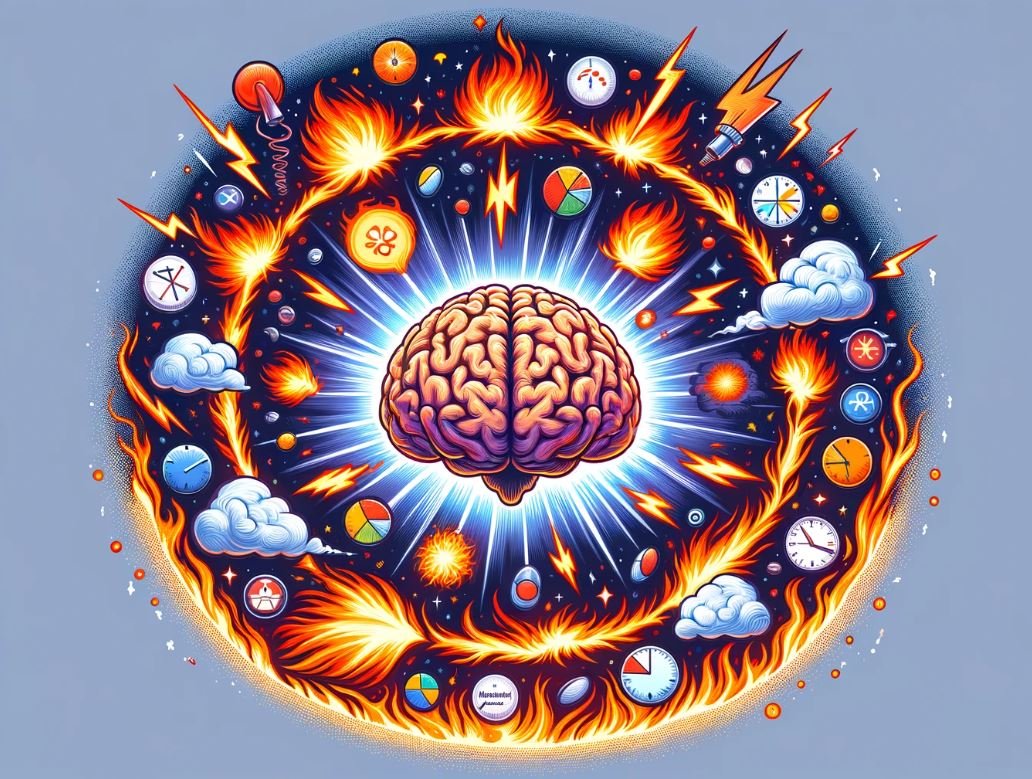In the ADHD spectrum, “Ring of Fire” ADHD stands out as a highly intense and multifaceted condition. Distinguished by pervasive hyperactivity across the brain, it’s a subtype brimming with emotional, sensory, and cognitive challenges. This article delves into the nuances of Ring of Fire ADHD, exploring its symptoms, causes, and treatment modalities while drawing from the expertise of mental health professionals.
Key Takeaways
- Ring of Fire ADHD is an intense subtype marked by emotional dysregulation, sensitivity, and pervasive brain hyperactivity.
- Potential triggers include inflammation, environmental factors, and prenatal influences.
- Treatment goes beyond traditional ADHD approaches, incorporating dietary changes, physical activity, and specific therapeutic and medicinal interventions.
Unveiling Ring of Fire ADHD
Characterized by Dr. Daniel Amen, Ring of Fire ADHD is marked by a suite of symptoms beyond the conventional ADHD triad of inattention, impulsivity, and hyperactivity. Individuals may experience severe emotional dysregulation, sensitivity to sensory stimuli, and a relentless stream of thoughts and ideas. Symptoms extend to irritability, rapid speech, inflexible thinking, and a heightened state of anxiety, painting a complex picture of constant mental and emotional tumult.
The name “Ring of Fire” itself mirrors the condition’s nature: an intense, encompassing circle of brain activity that sets it apart from other ADHD types. This subtype is also associated with environmental sensitivities and a pronounced struggle with mood stability.
Tracing the Origins
While the root causes of Ring of Fire ADHD remain under investigation, factors like inflammation, prenatal influences, and environmental toxins are considered significant contributors. Dr. Amen suggests that allergies, infections, or brain inflammation could be triggering this heightened brain activity. It’s a realm requiring more research but offers a fascinating insight into how diverse factors intertwine to shape ADHD manifestations.
Navigating the Treatment Landscape
Addressing Ring of Fire ADHD requires a nuanced approach, tailored to the individual’s complex symptomatology. Dr. Amen advocates for strategies beyond traditional stimulant medication, given the subtype’s unique brain activity patterns. An elimination diet, for instance, can help identify allergenic or inflammatory foods. Regular physical activity, aimed at tempering hyperactivity and boosting mood-regulating neurotransmitters, is another cornerstone.
Therapeutic interventions also play a pivotal role. Cognitive-behavioral therapy (CBT) assists in managing detrimental thought patterns, while mood-stabilizing medications may offer relief for those grappling with the subtype’s intense emotional fluctuations. Each strategy aims to bring balance to the whirlwind of sensations and emotions characteristic of Ring of Fire ADHD.
Embracing the complexity of Ring of Fire ADHD paves the way for more effective, personalized care strategies. Understanding and addressing this condition’s unique aspects can significantly enhance life quality for those affected. For more in-depth insights, exploring expert resources can provide valuable guidance and support .
Detailed Questions
1. How does Ring of Fire ADHD differ from other types of ADHD, and what unique challenges does it present?
Ring of Fire ADHD is a type of ADHD that is described as having intense symptoms compared to other types. It involves overactivity across the entire brain, which leads to heightened sensitivity to environmental stimuli, emotional dysregulation, and irritability. This subtype is also characterized by rapid thought processes and difficulties in managing emotions, making it more complex to treat than other forms of ADHD.
The challenges presented by Ring of Fire ADHD include managing extreme mood swings and maintaining stable relationships. Individuals may find social interactions particularly strenuous due to their hypersensitivity and rapid mood changes. The intense brain activity can result in a constant state of overwhelm, making everyday tasks and decision-making much more challenging.
Treatment for Ring of Fire ADHD often requires a multi-faceted approach that goes beyond typical ADHD medications. It may involve dietary changes, therapy, exercise, and in some cases, specific medications like anticonvulsants. This subtype demands a tailored treatment plan, as traditional stimulant medications can exacerbate symptoms.
- Ring of Fire ADHD features intense brain activity and sensitivity.
- It presents unique challenges in emotion regulation and social interactions.
- Treatment requires a comprehensive approach beyond conventional ADHD medication.
2. What are the potential causes of Ring of Fire ADHD, and how does this inform treatment?
The exact causes of Ring of Fire ADHD are not fully understood but are believed to include factors like inflammation, environmental toxins, and prenatal influences. Research suggests a link between brain inflammation and ADHD symptoms, though whether inflammation is a cause or consequence of ADHD is still under debate. This connection to physical health factors like allergy or infection offers a different perspective on treatment approaches.
Understanding the underlying causes informs treatment by highlighting the importance of addressing inflammation and environmental factors. Treatments may include an elimination diet to identify and remove allergens, as well as supplementation with anti-inflammatory nutrients like omega-3 fatty acids. Regular physical activity is also emphasized to help reduce hyperactivity and improve overall brain health.
This subtype’s connection to physical health emphasizes a holistic treatment approach. By considering diet, exercise, and mental health strategies, the treatment for Ring of Fire ADHD becomes more comprehensive, targeting both the brain’s overactivity and the body’s health.
- Potential causes include inflammation and environmental factors.
- Treatment strategies may include dietary changes and physical activity.
- A holistic approach is crucial for effectively managing Ring of Fire ADHD symptoms.
3. How is Ring of Fire ADHD diagnosed, and what does the diagnosis process involve?
Ring of Fire ADHD is typically diagnosed through comprehensive evaluations that may include interviews, review of medical history, and SPECT scans. SPECT (Single Photon Emission Computed Tomography) scans can provide a detailed view of brain activity patterns, which helps in identifying the unique brain activity associated with this ADHD subtype. The diagnostic process is aimed at creating personalized treatment plans based on the specific brain patterns observed.
The diagnosis of Ring of Fire ADHD, however, is not universally accepted within the medical community as a formal subtype of ADHD, as outlined by the current DSM-5. Despite this, the symptoms associated with Ring of Fire ADHD can align with broader ADHD diagnostic criteria. A mental health professional can evaluate these symptoms to provide a diagnosis and recommend an appropriate treatment path.
Diagnosis is crucial for understanding and managing Ring of Fire ADHD effectively. By identifying the unique characteristics of this subtype, healthcare professionals can tailor interventions to address the specific challenges and brain activity patterns of individuals.
- Diagnosis involves comprehensive evaluation and may use SPECT scans.
- Ring of Fire ADHD is not recognized as a formal subtype in DSM-5 but can be identified by symptoms.
- Accurate diagnosis is essential for tailored treatment and management.
4. What lifestyle changes can support the treatment of Ring of Fire ADHD?
Lifestyle changes play a crucial role in managing Ring of Fire ADHD. Regular physical activity is recommended to reduce hyperactivity and promote brain health. Exercise increases blood flow to the brain and can help regulate neurotransmitters, contributing to improved mood and cognitive function.
Dietary adjustments are also crucial, including adopting an elimination diet to identify potential allergens or triggers that may exacerbate ADHD symptoms. Consuming a balanced diet rich in anti-inflammatory foods like berries, leafy greens, and omega-3-rich fish can support overall brain health and reduce inflammation.
Stress reduction techniques, such as mindfulness meditation and deep breathing exercises, can also be beneficial. These practices help manage stress, reduce inflammation, and improve emotional regulation, crucial aspects of Ring of Fire ADHD treatment.
- Regular exercise and dietary changes are key lifestyle modifications.
- Stress reduction techniques can help manage emotional dysregulation.
- These changes support overall treatment and improve quality of life.
5. What is the role of support systems in managing Ring of Fire ADHD, and how can they be developed?
Support systems are vital in managing Ring of Fire ADHD. They provide emotional support, understanding, and practical assistance. Family, friends, and healthcare professionals can offer critical support by helping with organization, providing reminders, and encouraging treatment adherence. It’s important to educate the support network about Ring of Fire ADHD’s unique challenges so they can offer the most effective help.
Building a strong support system involves open communication about the individual’s needs and struggles. This can include discussing the symptoms of Ring of Fire ADHD, sharing effective coping strategies, and setting up regular check-ins. Joining support groups, either in person or online, can provide additional resources and a sense of community.
Professional support is also key in managing Ring of Fire ADHD. Therapists, psychiatrists, and ADHD coaches can offer guidance, support, and strategies tailored to the individual’s needs. They can also help families and individuals to build and maintain a supportive environment, essential for successful management of the condition.
- Support systems provide emotional, practical, and treatment-related support.
- Building this system involves open communication, education, and regular check-ins.
- Professional support from therapists, psychiatrists, and ADHD coaches is crucial.
10 FAQ Questions with Responses
1. What is Ring of Fire ADHD?
Ring of Fire ADHD is a subtype characterized by intense symptoms such as emotional dysregulation, hypersensitivity, and pervasive brain hyperactivity.
2. How does Ring of Fire ADHD differ from classic ADHD?
It involves more severe mood swings, sensitivity to stimuli, and constant high levels of brain activity, unlike the more focused symptoms of classic ADHD.
3. What causes Ring of Fire ADHD?
The exact causes are unknown, but factors like inflammation, environmental toxins, and prenatal influences are believed to contribute.
4. How is Ring of Fire ADHD diagnosed?
It is typically diagnosed through comprehensive evaluations that may include interviews, review of medical history, and brain imaging techniques like SPECT scans.
5. Can Ring of Fire ADHD be treated with stimulant medication?
Stimulant medication can sometimes worsen symptoms of Ring of Fire ADHD; treatment often involves a combination of dietary changes, exercise, and non-stimulant medications.
6. Are there natural treatments for Ring of Fire ADHD?
Yes, treatments may include dietary changes, physical activity, and supplements like omega-3 fatty acids.
7. How can lifestyle changes help manage Ring of Fire ADHD?
Regular exercise, a healthy diet, and stress-reduction techniques can help manage symptoms.
8. What role does inflammation play?
Inflammation is believed to be a significant factor, possibly exacerbating the symptoms.
9. Is Ring of Fire ADHD officially recognized by medical professionals?
While it is used by some practitioners, it is not a formally recognized subtype in the DSM-5.
10. How can a support system help someone with Ring of Fire ADHD?
A support system can provide emotional support, help with organization, and encourage adherence to treatment plans.
For further understanding and managing mental health challenges, you might want to explore additional resources such as What are the Key Signs of Stress Affecting Mental Health?, Why Might Someone Avoid Getting Help for a Mental Health Concern?, Mental Instability: Navigating the Complex Landscape, Understanding Postpartum Mental Disorders, and Coping with New Job Stress.


